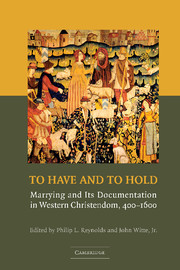Book contents
- Frontmatter
- Contents
- List of Contributors
- Preface and Acknowledgments
- List of Abbreviations
- 1 Marrying and Its Documentation in Pre-Modern Europe: Consent, Celebration, and Property
- 2 Marrying and Its Documentation in Later Roman Law
- 3 Marrying and the Tabulae Nuptiales in Roman North Africa from Tertullian to Augustine
- 4 Dotal Charters in the Frankish Tradition
- 5 Marriage and Diplomatics: Five Dower Charters from the Regions of Laon and Soissons, 1163–1181
- 6 Marriage Agreements from Twelfth-Century Southern France
- 7 Marriage Contracts in Medieval England
- 8 Marriage Contracts and the Church Courts of Fourteenth-Century England
- 9 Marrying and Marriage Litigation in Medieval Ireland
- 10 Marriage Contracts in Medieval Iceland
- 11 Contracting Marriage in Renaissance Florence
- 12 Marital Property Law as Socio-Cultural Text: The Case of Late-Medieval Douai
- 13 Marriage Contracts, Liturgies, and Properties in Reformation Geneva
- Index
Preface and Acknowledgments
Published online by Cambridge University Press: 12 September 2009
- Frontmatter
- Contents
- List of Contributors
- Preface and Acknowledgments
- List of Abbreviations
- 1 Marrying and Its Documentation in Pre-Modern Europe: Consent, Celebration, and Property
- 2 Marrying and Its Documentation in Later Roman Law
- 3 Marrying and the Tabulae Nuptiales in Roman North Africa from Tertullian to Augustine
- 4 Dotal Charters in the Frankish Tradition
- 5 Marriage and Diplomatics: Five Dower Charters from the Regions of Laon and Soissons, 1163–1181
- 6 Marriage Agreements from Twelfth-Century Southern France
- 7 Marriage Contracts in Medieval England
- 8 Marriage Contracts and the Church Courts of Fourteenth-Century England
- 9 Marrying and Marriage Litigation in Medieval Ireland
- 10 Marriage Contracts in Medieval Iceland
- 11 Contracting Marriage in Renaissance Florence
- 12 Marital Property Law as Socio-Cultural Text: The Case of Late-Medieval Douai
- 13 Marriage Contracts, Liturgies, and Properties in Reformation Geneva
- Index
Summary
Throughout much of the West today, marriage formation requires the execution of a written marriage contract – usually a marriage certificate that is signed by the couple and their witnesses and registered with a government official. These publicly registered marriage contracts can be anticipated by private engagement and prenuptial contracts respecting the parties' property, custodial, and other rights before, during, and after the marriage. Marriage contracts may also be accompanied by public notices and invitations; elaborate liturgies or ceremonies; ritual exchanges of promises, rings, and other property; and lavish parties and lush honeymoons. But none of this is essential to the validity of the marriage today: the properly signed marriage certificate is enough to make a marriage.
In the pre-modern West, both the documentation and the formation of marriage were considerably more complex and variegated. Most so-called marriage contracts in the Middle Ages were, in fact, primarily marriage settlements: they recorded agreements about transfers of marital property, and although they often referred to the mutual consent of the parties to form a marital union, they did so only to situate the settlement in its proper context. Moreover, the relationship between written marriage contracts and the contract of marriage per se varied considerably over time and across cultures. Some of the documents recorded the marriage itself; some did not. Some of them were intended for use at weddings; some were not. Some of the documents included commentary on the legal, ethical, or religious function of marriage; some did not.
- Type
- Chapter
- Information
- To Have and to HoldMarrying and its Documentation in Western Christendom, 400–1600, pp. ix - xivPublisher: Cambridge University PressPrint publication year: 2007



